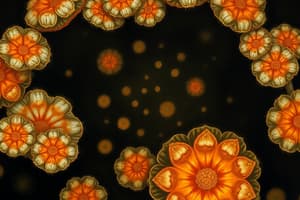Podcast
Questions and Answers
Match the following microbial types with their cellular characteristics:
Match the following microbial types with their cellular characteristics:
Bacteria = Prokaryotic, unicellular Archaea = Prokaryotic, unicellular Fungi = Eukaryotic, unicellular or multicellular Viruses = Non-cellular, protein + nucleic acid
Match the following symbiotic relationships with their descriptions:
Match the following symbiotic relationships with their descriptions:
Mutualism = Host and Microbe benefit Commensalism = Host unaffected, Microbe benefits Parasitism = Host hurt, Microbe benefits Opportunistic Pathogens = Prey on weak host
Match the following terms with their definitions:
Match the following terms with their definitions:
Endemic diseases = Occurring in a specific community Sporadic diseases = Occurring without concentration Pandemics = Internationally occurring Emerging diseases = New or re-populating disease
Match the following scientists with their contributions to microbiology:
Match the following scientists with their contributions to microbiology:
Match the following bond types with their descriptions:
Match the following bond types with their descriptions:
Match the following chemical reactions with their descriptions:
Match the following chemical reactions with their descriptions:
Match the following functional groups with their characteristics:
Match the following functional groups with their characteristics:
Match the following macromolecules with their building blocks:
Match the following macromolecules with their building blocks:
Match the following types of carbohydrates with their examples:
Match the following types of carbohydrates with their examples:
Match the following terms related to bacterial structure with their corresponding descriptions:
Match the following terms related to bacterial structure with their corresponding descriptions:
Match the following types of lipids with their characteristics:
Match the following types of lipids with their characteristics:
Match the following types of bacteria with their characteristic shapes:
Match the following types of bacteria with their characteristic shapes:
Match the following terms related to eukaryotic cell structures with their corresponding functions:
Match the following terms related to eukaryotic cell structures with their corresponding functions:
Match the following types of staining methods with their applications:
Match the following types of staining methods with their applications:
Match the following types of media with their characteristics:
Match the following types of media with their characteristics:
Match the following terms related to eukaryotic cell processes with their definitions:
Match the following terms related to eukaryotic cell processes with their definitions:
Match the following terms related to bacterial cell walls with their descriptions:
Match the following terms related to bacterial cell walls with their descriptions:
Match the following types of cellular structures with their primary function:
Match the following types of cellular structures with their primary function:
Flashcards
Prokaryotes
Prokaryotes
Unicellular organisms without a nucleus, such as bacteria and archaea.
Eukaryotes
Eukaryotes
Organisms with a nucleus, can be unicellular or multicellular, like protists and fungi.
Mutualism
Mutualism
A type of symbiosis where both host and microbe benefit.
Commensalism
Commensalism
Signup and view all the flashcards
Parasitism
Parasitism
Signup and view all the flashcards
Viruses
Viruses
Signup and view all the flashcards
Prions
Prions
Signup and view all the flashcards
Koch’s Postulates
Koch’s Postulates
Signup and view all the flashcards
Abiogenesis
Abiogenesis
Signup and view all the flashcards
Acids
Acids
Signup and view all the flashcards
Covalent Bonds
Covalent Bonds
Signup and view all the flashcards
Lipids
Lipids
Signup and view all the flashcards
Cell Wall
Cell Wall
Signup and view all the flashcards
Flagella
Flagella
Signup and view all the flashcards
Biofilms
Biofilms
Signup and view all the flashcards
Penicillin sensitivity
Penicillin sensitivity
Signup and view all the flashcards
Plasmids
Plasmids
Signup and view all the flashcards
Cytoskeleton
Cytoskeleton
Signup and view all the flashcards
Endocytosis
Endocytosis
Signup and view all the flashcards
Mitochondria
Mitochondria
Signup and view all the flashcards
Negative stain
Negative stain
Signup and view all the flashcards
Rough ER
Rough ER
Signup and view all the flashcards
Selective media
Selective media
Signup and view all the flashcards
Study Notes
Chapter 1: Cellular and Non-Cellular Organisms
- Prokaryotes: Bacteria and Archaea; unicellular; no nucleus.
- Eukaryotes: Protists, Fungi, Helminths; unicellular or multicellular; have a nucleus and organelles.
- Viruses: Non-cellular; protein + nucleic acid.
- Prions: Non-cellular; protein only.
- Reproduction: Prokaryotes reproduce asexually (binary fission); Eukaryotes reproduce asexually (mitosis) or sexually (meiosis).
Chapter 1: Microbial Interactions & Disease
- Symbiotic Relationships:
- Mutualism: Both host and microbe benefit.
- Commensalism: Host unaffected; microbe benefits.
- Parasitism: Host harmed; microbe benefits.
- Types of Pathogens:
- Normal Pathogens: Present on the skin.
- Transient Pathogens: Come and go.
- Opportunistic Pathogens: Attack weakened hosts.
- True Pathogens: Always cause disease in a healthy host.
- Emerging Pathogens: New or re-emerging diseases.
- Re-emerging Pathogens: Formerly controlled diseases re-emerging.
- Disease Patterns: Endemic, sporadic, pandemic
Chapter 1: Historical Figures and Concepts
- Biogenesis: Life comes from life.
- Abiogenesis: Life comes from non-living things.
- Leeuwenhoek: Invented the microscope.
- Pasteur: Demonstrated that dust in the air is a source of microorganisms via swan-neck flask experiment.
- Koch's Postulates: Criteria to establish a specific microbe as the cause of a particular disease.
- Redi: Experiments with meat in jars to validate biogenesis against spontaneous generation.
- Lister: Pioneered sterilization techniques.
- Jenner: Developed smallpox vaccination.
- Semmelweis: Introduced aseptic techniques.
- Needham: Results supported abiogenesis.
Chapter 1 : Key Terms
- Etiology: The cause of a disease (intrinsic, extrinsic, idiopathic)
- Taxonomic Categories: Domain, Kingdom, Phylum, Class, Order, Family, Genus, Species (e.g., Genus species)
Chapter 2: Atoms, Molecules, and Bonds
- Atoms: Simplest form of an element, indivisible.
- Elements: Made of atoms; 95% of body weight: C, H, O, N, S, P
- Subatomic Particles: Proton (positive), neutron (neutral), electron (negative).
- Atomic Number: Number of protons.
- Mass Number: Number of protons + neutrons.
- Isotopes: Forms of an element with different numbers of neutrons.
- Valence Electrons: Electrons in the outermost shell; determine bonding behavior.
- Molecule vs. Compound: Molecules (covalent bonds) form compounds (covalent or ionic bonds).
- Covalent Bonds: Sharing of electrons.
- Ionic Bonds: Transfer of electrons creating ions (cations + / anions -).
- Hydrogen Bonds: Weak polar bonds between hydrogen and electronegative atoms.
- Chemical Reactions: Synthesis (A+B=AB), Decomposition (AB=A+B), Exchange Reactions (AB+CD=AD+CB).
- Solutions: Solute + Solvent
- pH Scale: Measures hydrogen ion concentration; scale of 0-14. Acids (pH < 7); Bases (pH > 7).
- Organic Molecules: Molecules containing carbon and hydrogen.
- Carbon's Importance: 4 valence electrons, forms single, double and triple bonds.
- Functional Groups: Groups of atoms that impart specific chemical properties, found in organic molecules.
Chapter 2: Macromolecules
- Macromolecules: Large polymers built from monomers.
- Carbohydrates: Monosaccharides (glucose, fructose, galactose) → Disaccharides (maltose, sucrose, lactose), Polysaccharides (starch, glycogen, cellulose).
- Lipids: Fatty substances (triglycerides, fatty acids, phospholipids, steroids).
- Proteins: Chains of amino acids linked by peptide bonds.
- Nucleic Acids: DNA and RNA; composed of nucleotides.
Chapter 3: Microbial Morphology
-
Structures for Attachment and Motility:
- Flagella: Mobility; monotrichous, lophotrichous, amphitrichous, peritrichous, periplasmic.
- Fimbriae: Short, hair-like structures for attachment.
- Pili: Long, hollow appendages for conjugation.
-
External Appendages:
- Glycocalyx: General term for sticky outer layer
-
Slime Layer: Loose glycocalyx protecting from desiccation and nutrient loss.
-
Capsule: Polysaccharides and/or proteins bound firmly; protects from phagocytosis via immune cells.
-
Biofilms: Groups of microorganisms encased in a polysaccharide matrix
-
Cell Wall: Rigid structure for shape and protection, prevents lysis.
- Peptidoglycan: Present in bacteria; composed of alternating NAG and NAM subunits.
- Gram-Positive: Thick peptidoglycan layer. Susceptible to penicillin; contains teichoic acid; lipoteichoic acid.
- Gram-Negative: Thin peptidoglycan layer surrounded by an outer membrane.
- Mycobacteria: Has mycolic acid and PG
-
Cell Wall Variations:
- Mycoplasmas: Lack a cell wall.
- L-forms: Loss of cell wall due to mutation or treatment.
-
Protoplasts /Spheroplasts: Cells that have lost their cell wall.
-
Plasma Membrane: Phospholipid bilayer; regulates permeability.
-
Intracellular Structures:
- Nucleoid: Region where the DNA is located.
- Plasmids: Small circles of DNA replicating independently of the chromosome.
- Ribosomes: Site of protein synthesis.
- Cytoskeleton: Provides structure; made of protein filaments.
- Endospores: Dormant (protective) structures formed by some bacteria.
-
Bacterial Shapes: Coccus (spherical), Bacillus (rod-shaped), Spirillum (spiral), Spirochete (corkscrew).
-
Arrangement/ Grouping of Bacteria:
-
Streptococcus: Sphere-shaped bacteria arranged in chains.
-
Staphylococcus: Sphere-shaped bacteria arranged in clusters.
Chapter 4: Eukaryotic Cell Structure
- General Features: All eukaryotic cells contain membrane-bound organelles.
- Eukaryotic Cell Membrane: Phospholipid bilayer with sterols and proteins.
- Endomembrane system: ER, Golgi, lysosomes
- Endocytosis vs Exocytosis:
- Endocytosis: Uptake of materials by vesicles.
- Phagocytosis: Engulfing large particles.
- Pinocytosis: Uptake of fluids
- Exocytosis: Secretion of materials in vesicles.
- Constitutive vs regulated: Controlled secretion and non-controlled secretion
- Nucleus: Contains chromosomes, directs cell activity.
- Nucleolus: Site of ribosome synthesis within nucleus.
- Endoplasmic Reticulum (ER): Transport and synthesis of materials.
- Rough ER: Protein synthesis.
- Smooth ER: Lipid synthesis, metabolism, detoxification.
- Golgi Apparatus: Modifies and packages proteins.
- Lysosomes: Contain digestive enzymes.
- Mitochondria: Site of cellular respiration, ATP production
- Chloroplasts: Site of photosynthesis
- Ribosomes: Composed of 40S + 60S subunits.
- Cytoskeleton: Provides structure and movement.
Chapter 5: Staining and Culture Methods
- Staining: Techniques using dyes to visualize cells.
- Positive Stain: Dyes bind to cell components.
- Negative Stain: Dyes do not enter the cell; highlight background; cell outline is visible.
- Acid-Fast Stain: Differentiates mycobacteria.
- Specialized Stain: to identify special structures (flagella, capsule)
- Types of Media: Liquid, semi-solid, solid
- Simple media: general support for many bacteria
- Enriched media: Supplements for increased growth
- Reducing Media: Anaerobic growth
- Selective media: Grow desired bacteria.
- Differential Media: Distinguish microorganisms based on biochemical reactions (e.g. color change)
Studying That Suits You
Use AI to generate personalized quizzes and flashcards to suit your learning preferences.




